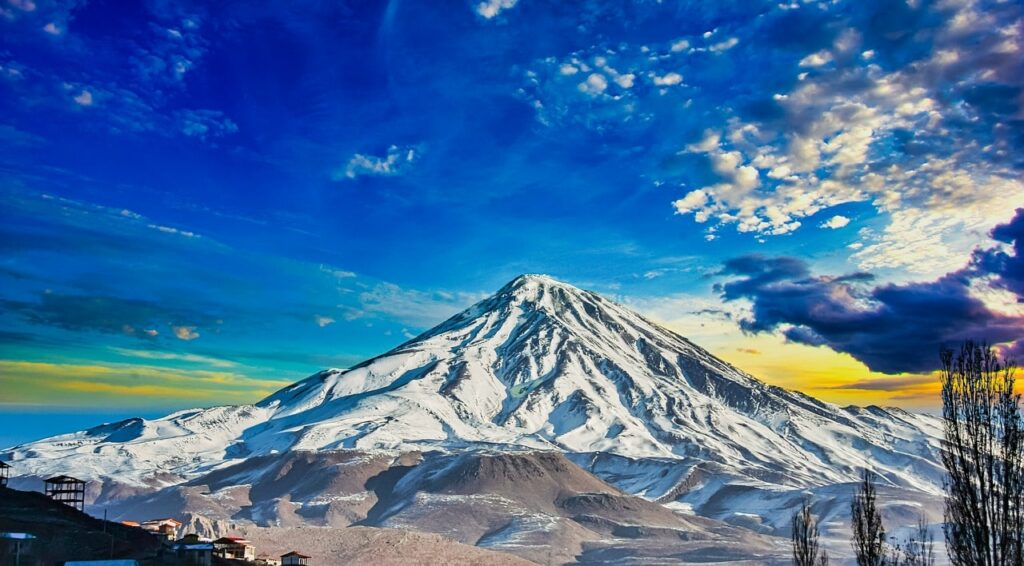The Middle East is famous for its deserts of vast sand dunes, camels and heavenly beaches in the middle of a thousand seas. But man does not live by sand and sea alone, as Iran is home to the highest volcano in the Middle East: Damavand.
Set in the middle of the Elbuz mountain range, which runs through the north of the country, this natural wonder is winning over Iranians and foreigners alike, who love winter sports and prefer to get away from the famous white roads in search of quieter spots. Read on to find out more about this Persian giant that leaves no one indifferent.
Damavand, a special mountain
Damavand, just 80 kilometres north of Tehran, is the highest mountain in the Elbuz mountain range that crosses northern Iran and stretches from Armenia to the borders of Turkmenistan and Afghanistan, on the opposite side from Turkey, located mainly on the European side.
Although there is no agreement on its exact altitude, this particular volcano is said to be 5,610 metres high according to the Iranian State Centre and SRTM, but in 2007 a height of 5,623 metres was recorded, which was later questioned because the same measurement claimed that the Caspian Sea was -17 metres, although it is actually -28 metres. The earliest figure puts the volcano's height at 5,671 metres and, although it is unsubstantiated, it is the measurement most frequently used on the Internet.
This particular mountain features prominently in Persian mythology, partly due to its impressive appearance, as it lies at the centre of the area where the Iranian people have always lived. Persian mythology recounts that Arash the archer climbed Damavand to shoot the arrow that would demarcate Iran's border with the Turanid people, and it was here that King Fereydun and Kaveh the blacksmith defeated the dragon Azhi Dahaka Zahhak.
Summer is the best time to travel
If you're thinking of climbing Iran's highest mountain, the best time to do so is during the summer season, as the rest of the year there is too much snow to allow you to climb the summit without difficulty.
So the first thing to do is to prepare your suitcase for travelling in summer, even if you're only planning to visit Damavand. In addition to your mountain clothes, it's a good idea to pack some light clothes that will cover you up when you're out and about in the Iranian capital. If you are a woman, remember to always wear your arms covered, loose clothing under your hips and a headscarf.
This is compulsory for both native and foreign women, otherwise the morality police will quickly reprimand you. In addition, to enter certain temples, it is compulsory to wear a chador, but in these cases they are generally lent or hired at the entrance.
If you're a man, it's not that complicated, although it's not recommended to wear a sleeveless shirt or trousers above the knees, but it's less common to be questioned by the vice police.
Damavand: a challenge for mountaineers
There are at least 16 routes to the summit, with varying degrees of difficulty, from very dangerous routes involving rock climbing to others more suitable for amateur adventurers. The best-known and easiest route is the southern one, which has a camp at 4,220 metres, making it easier to acclimatise.
The longest route is the north-west route and it takes two full days to reach the summit, starting from the town of Nāndal and spending a night at Takht-e Fereydoun (at 4,300 metres). Another well-known route is the western route, famous for its spectacular sunsets.
The Persian giant is a real challenge for travellers, as its great slopes make them climb almost 2,000 metres a day, causing what is known as acute mountain sickness. If you've never hiked at high altitude before, we recommend that you start with other types of mountain to see how your body acclimatises, as the climbs in Damavand generally cause dizziness, headaches, problems falling asleep and other discomforts typical of altitude.
As for the rest, if you're planning to do one of the simpler routes, all you need to do is bring some general mountain gear and drink plenty of fluids to help you acclimatise and get the most out of your ascent of Damavand, an experience you won't forget.

